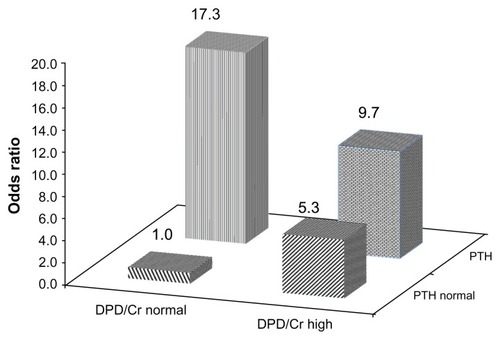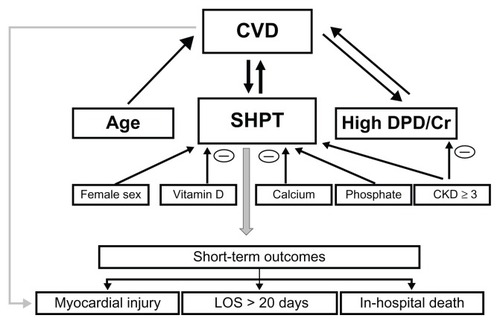Figures & data
Table 1 Socio-demographic and clinical characteristics of older patients with hip fracture included in the study (n = 746)
Table 2 Parameters of mineral and bone metabolism in older hip-fracture patients with and without cardiovascular disease
Table 3 Pearson correlation coefficients between serum PTH levels and selected clinical, mineral, and bone metabolism factors in older hip-fracture patients with and without cardiovascular disease
Table 4 Independent factors associated with the presence of cardiovascular disease in older hip-fracture patients
Table 5 Multivariate-adjusted odds ratio for the presence of cardiovascular disease in older hip-fracture patients with elevated serum parathyroid hormone levels (>6.8 pmol/L)
Table 6 Odds ratios for presence of cardiovascular disease according to serum PTH concentrations as urinary deoxypyridinoline excretion in older patients with hip fracture
Figure 1 Odds ratios for presence of cardiovascular disease in older patients with hip fracture according to serum parathyroid hormone and urinary deoxypyridinoline levels.
Abbreviations: PTH, parathyroid hormone; DPD/Cr, deoxypyridinoline corrected by urinary creatinine; 25(OH)D, 25-hydroxyvitamin D; eGFR, estimated glomerular filtration rate.

Table 7 Use of cardiovascular medications and serum parathyroid hormone and vitamin D status
Figure 2 Diagram showing significant independent relationships (as documented by multiple regression analyses) between cardiovascular disease and parameters of mineral-bone metabolism, age and sex and short-term outcomes.
Abbreviations: CVD, cardiovascular disease; SHPT, secondary hyperparathyroidism (PTH > 6.8 pmol/l); high DPD/Cr, deoxypyridinoline corrected by urinary creatinine excretion > 7.5 nmol/μmol; CKD ≥ 3, chronic kidney disease stage 3 or higher (eGFR < 60 mL/minute/1.73 m2); LOS, length of hospital stay; PTH, parathyroid hormone; eGFR, estimated glomerular filtration rate.
